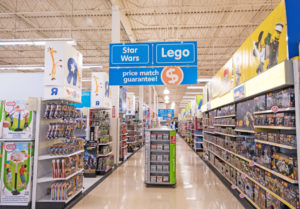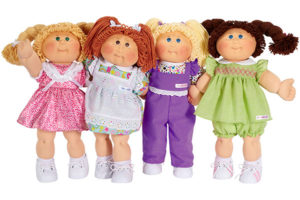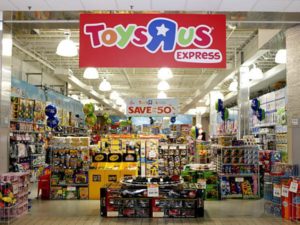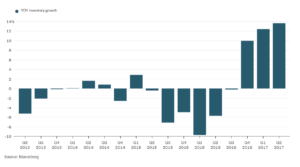These days, it seems that everyone from factory workers to United States president-elect Donald Trump cannot help but reminisce about the ever-vague “good old days.” Many say these were simpler, more predictable times, and it was easy to repeatedly use the same strategy to find success. This is no longer the case, and people and industries as a whole have had to shift their mindsets and continuously innovate in order to stay afloat. This is perhaps most evident in the toy industry and Toys “R” Us specifically as both have been through a roller coaster of progress throughout the last few decades as technology has gotten better and toy preferences have changed.
The modern toy industry was born at the end of World War II. The Great Depression and the World Wars did not leave people with much spending money, but the return of prosperity and the introduction of television and plastic propelled modern American consumption. This was perfect timing for Toys R Us founder Charles Lazarus, who believed that “toys are a great kind of thing to sell, because they don’t last that long.” Lazarus’ strategy was to offer name-brand merchandise at less than list price, and toy manufacturers were willing to compromise because Toys R Us was one of the only retailers that offered year-round sales. Traditionally, toy stores did 70% of its sales during the 6 weeks leading up to Christmas. This meant that the carefully selected stocks of toys were cut dramatically from January to August, which made the toy year short and unsustainable. Toys R Us was unique in that its stocks were maintained throughout the year with toys from manufacturers’ entire catalogues.
Toys R Us stores revolutionized the toy industry. Whereas toy stores used to be small with much of their merchandise stashed in the back room, Toys R Us introduced the warehouse shopping experience. Toy packaging design was now centered on how it would look on the shelf, and from 1975 to 1985, annual revenues at Toys R Us grew from just over $200 million to over $2 billion. The emphasis on the shopping experience worked, and it brought in great success for that time.
Ironically, the toy’s short lifecycle that attracted Lazarus in the first place needed to be adjusted in order for the industry to have consistent sales. Toys that only get played with once or twice is a waste of money in the parents’ eyes, so for a line to stay popular over time, children must want to continue playing with it. The emphasis on sustainable toy lines also keeps prices down by allowing manufacturers more time to get their return on investment while keeping quality up. Children only return to a toy if it has a deeper meaning than just being a plastic object. This could be in the form of a story that is supplemented by a television short or a movie. In the 1980s, the Cabbage Patch dolls and the Transformers took exactly this route, which allowed children to better relate to their toys. Unfortunately, the 90s brought the Internet and technology that offered instant gratification, and static toys no longer held the same appeal.
Instead of producing a toy and creating a story to go with it, toymakers began seeing the benefit of making the two a more streamlined experience through videogames or interactive toys. Videogames tell the story over time, and children can play by themselves in a way that keeps them engaged. In the early 90s, toy spending peaked for four-year-olds, but by the end of the decade, the peak for spending was for three-year-olds. Children were simply outgrowing their toys earlier and finding more interest in electronic games at a younger age.
This shift forced Toys R Us to revamp their stores, and in 1998, it greatly expanded its electronic section. While this was new for Toys R Us, its competition already offered that and more. Wal-Mart, Target, and other discount stores put pressure on Toys R Us as they captured more and more of the toy business. In the mid-90s, Toys R Us held 20% of the market, and Wal-Mart and Target were insignificant. By 2004, Wal-Mart had 20% of the market, Target had 18%, and Toys R Us was down to 17%.
In the 90s, many moms including Kathy Klatman used to regularly shop at Toys R Us, buying dolls and play sets from the toy giant. By the mid-2000s, all of the toys she bought fell into two categories: the more expensive toys, such as American Girl Dolls, were bought through catalog, and the cheap toys, like Matchbox cars, were purchased during her weekly shopping trips to Target. Unfortunately, this did not leave much space for Toys R Us. Klatman says that her kids “already have so many things to play with that [she has] a tendency to look for quality and whether they will play with it for a long time.” When the kids need to be pacified with a simple toy, she can easily pick them up at Target cheaper than she could at Toys R Us.
This was a troubled time for Toys R Us; however, the retailer came up with a plan to stay competitive. In 2000, Amazon and Toys R Us signed a ten-year agreement in which Amazon would devote part of its website to products chosen specifically by Toys R Us. This allowed Toys R Us to select the most popular products and get them to customers more easily. This alliance was widely applauded as a seamless connection between traditional brick-and-mortar stores and new-age Internet companies, but it eventually became entangled in allegations that both sides were not doing as they promised. Toys R Us accused Amazon of allowing other companies to sell toys through their website, and Amazon claimed that Toys R Us was not maintaining a high quality selection of toys. The biggest problem was that online toy sales just were not at the level that both parties anticipated, so they were not making the profits they hoped. By 2004, lawsuits from both sides effectively ended their contract, and Toys R Us was left on its own again.
Toys R Us was at a crossroads. It seemed on the verge of collapse as its market share decreased and the falling out with Amazon worsened. Toys R Us had actually given up rights to its own website in its partnership, so there was not much hope for a quick rebound in online sales. However, Toys R Us was more motivated than ever to take back their place at the top of the toy industry, and they did so by acquiring three pertinent brands: FAO Schwartz, eToys.com, and KB Toys. As much as Toys R Us suffered during this period, its smaller rivals were on the verge of bankruptcy, which meant that Toys R Us could acquire them at a relatively low cost. The acquisitions allowed Toys R Us access to the companies’ established websites, trademarks, and some of their stores. All three of these companies already had well-known brand names, which gave Toys R Us the opportunity to sell a wider variety of products.
To give a greater push during the holidays, Toys R Us began opening temporary pop-up stores that were smaller but require less staff and stock. They were located in malls and shopping centers that could not hold the traditionally massive warehouses of Toys R Us. The widespread and obvious presence of the retailer garnered high sales and happy customers. This was so successful that the company ended up keeping a third of its locations after the holidays in 2010.
Toys R Us also benefitted as the industry as a whole made its comeback. From 2014 to 2015, annual toy sales rose over 6% to $19.9 billion, which was the largest increase in ten years. Popular Hollywood films fueled the popularity of collectibles, which boosted sales like it had in the 80s and 90s. This not only appealed to children, but it also helped toy manufacturers capture the preteen and adult crowds with paraphernalia from movies like Star Wars. Even Frozen, a movie targeted for children, was able to become a top toy brand with $531 million in sales in 2014.
There were also huge developments in technology, which gave toys the ability to interact with children in a more animated and stimulating way. Toys are able to interpret speech and react in the appropriate way using chip technology, which has become cheaper and more powerful. Dolls can have conversations with users and toy cars can be controlled by smartphones. The new Barbie Dreamhouse by Mattel is voice activated, and the music, appliances, and even the elevator can be controlled by simple commands. In this modern era of touch screens and applications, toy manufacturers have to put in extra effort to make sure that physical toys can compete with the seemingly limitless iPads and smartphones.
As for its competition, Toys R Us can be proud to report strong sales, especially during the holiday season. Sales went up 3.7% in the holiday season of 2015 compared to that of 2014 for stores open at least a year. The demand was high for toys, learning products, and seasonal goods, and low for electronics, video game consoles, and videogames. The advantage that Toys R Us has over Wal-Mart and Amazon is that Toys R Us is in the toy business for the entire year, whereas its competition only pushes toy sales during the end of the year. Vendors know this, and they can give Toys R Us more favorable margins.
Toys R Us also has had great success internationally, especially in Canada and Japan. Sales went up 13% in Canada in 2015, and Toys R Us became the largest retailer of children’s products in Japan. The retailer used partnerships to cater to the Japanese market specifically, and there was a strong cultural fit. Japanese families often allow children to choose their own gifts, so the store layout and experience was well-matched with their culture.
Looking to the future, Toys R Us CEO Dave Brandon wants to revamp its stores by turning them into an experiential destination. By creating an interactive space, he hopes that children will begin dragging their parents down to the stores to play at Toys R Us on weekends. Children already love the store, and by giving it this new dimension, they will want to continue going back. The company is now testing sound effects and colorful lights, and they are unboxing more toys in play areas. They are also hosting events including card trading and birthday parties.
Toys R Us is already moving towards their goals, and by mid-2017, the company projects 14% inventory growth. This will make their inventories at the highest amount in almost a decade, and it is proof that they are serious about putting money back into operations. Toys R Us seems to be moving in the right direction, and now it is a waiting game whether the company will go for an initial public offering. The retailer needs to have a successful 2016 holiday period in order to lay the groundwork for a potential second run at an IPO. Toys R Us was a public company until 2005, when it was taken private by investors for $6.6 billion. With strong sales and measureable improvements, 2017 may be the right time for private equity backers to strike. The toy industry will continue to be volatile as technology changes and competition gets tighter; however, Toys R Us has been in the game for quite a while now, and it has gained knowledge and experienced that will help it navigate the whirlwind of its market. Toymakers have every reason to root for Toys R Us, and hopefully, the children of today and the future will make Toys R Us great again.






Leave a Reply
You must be logged in to post a comment.